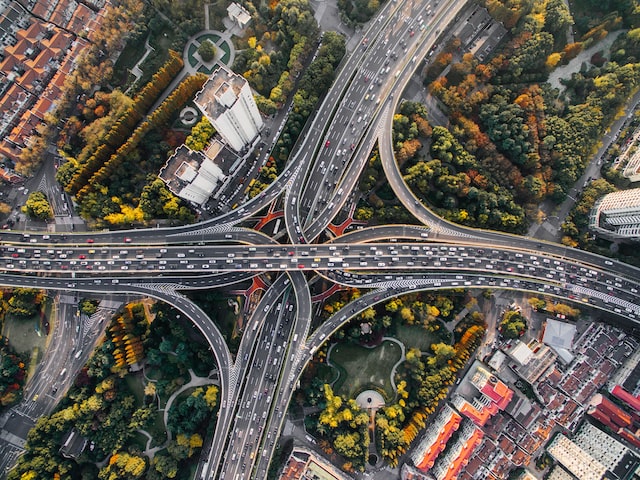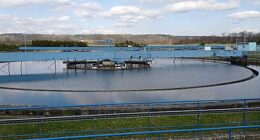Contraflow refers to traffic moving in the opposite direction of the normal flow on a roadway, usually implemented as a traffic management strategy during roadwork or accidents. With flow refers to traffic moving in the same direction as the normal flow on a roadway, this is the typical situation in normal traffic conditions.
What is contraflow and with flow?
(Photo by Denys Nevozhai on Unsplash )

Contraflow refers to the movement of traffic in the opposite direction of the normal flow on a roadway. This can happen for a variety of reasons, such as during roadwork or accidents. Contraflow is usually implemented as a traffic management strategy to maintain the flow of traffic during these events. An example of contraflow would be when one lane of a two-lane road is closed for construction and traffic is redirected to move in the opposite direction on the remaining lane.
With flow, on the other hand, refers to traffic moving in the same direction as the normal flow on a roadway. This is the typical situation in normal traffic conditions, where vehicles move in the same direction as the posted signs and road markings. With flow traffic is the regular flow of traffic, which is the normal scenario in most of the time.
The benefits of contraflow
- Maintaining traffic flow: Contraflow can help maintain the flow of traffic during times when one lane or a portion of a roadway is closed, such as during roadwork or accidents.
- Reducing congestion: By redirecting traffic in the opposite direction, contraflow can help reduce congestion and minimize delays for drivers.
- Improving safety: Contraflow can also improve safety by reducing the number of vehicles on the road in areas where work is being done, reducing the risk of accidents or collisions.
- Reducing the impact on local communities: Contraflow can help minimize the impact on local communities by diverting traffic away from the area and reducing the number of vehicles on the road.
- Improving emergency response: Contraflow can improve emergency response by allowing emergency vehicles to reach the scene of an accident or emergency more quickly and safely.
- Balancing traffic flow: Contraflow can also be used to balance the traffic flow between different directions or lanes.
It’s important to note that contraflow should be planned and implemented carefully, taking into account the specific conditions of the road and the surrounding area, and the potential impact on traffic and local communities.
The benefits of with flow
- Ease of navigation: With flow traffic makes it easier for drivers to navigate the road, as they are following the usual direction of travel.
- Reduced confusion: With flow traffic helps to reduce confusion for drivers, as they are less likely to get lost or make wrong turns.
- Improved safety: With flow traffic can also improve safety as drivers are less likely to make mistakes or cause accidents due to confusion.
- Increased efficiency: With flow traffic can also increase the efficiency of the road network by ensuring that vehicles are moving in the direction that they are intended to move.
- Reduced delays: With flow traffic can also reduce delays for drivers, as they are less likely to encounter unexpected roadblocks or detours.
- Maintenance of traffic flow: With flow allows traffic to move smoothly and orderly, this helps to maintain the traffic flow and reduce congestion.
It is important to note that with flow is the normal scenario for traffic flow in most of the time, and deviations from it, like contraflow, should be done with caution and with a proper plan and execution.
Does contraflow system reduce traffic?
(Photo by Koushik Pal on Unsplash )

There are many opinions on whether or not contraflow systems actually reduce traffic. Some say that it does, while others believe that it doesn’t make a significant difference. However, there is no denying that contraflow systems can be effective in certain situations.
For example, if there is an accident on a highway and all lanes need to be closed, contraflow can be used to keep traffic flowing in one direction. This helps to avoid complete gridlock and keeps traffic moving, albeit slowly. In these situations, contraflow is often the best option available and can help to reduce overall traffic congestion.
Frequently asked questions about contraflow and with flow
What’s a with-flow bus lane?
A with-flow bus lane is a dedicated lane for buses that allows them to travel in the same direction as other traffic. This type of bus lane is typically used on busy roads where there is not enough space to create a separate, dedicated bus lane.
What vehicles can use with flow bus lane?
There are many types of vehicles that can use with flow bus lanes including buses, bicycles, cars, and trucks. The main difference between contraflow and with flow is that with flow allows vehicles to travel in both directions on the same side of the road. This can be helpful for reducing traffic congestion during peak hours.
Do contraflow systems have lower speed limits?
Yes, contraflow systems typically have lower speed limits in place. This is because the traffic flow is reversed and vehicles are required to travel in opposite directions. This can be confusing for drivers, so it’s important to reduce speeds to help promote safe driving conditions.
Can taxis use contra flow bus lanes?
Yes, taxis are allowed to use contra flow bus lanes in the United Kingdom. However, they must comply with all the other rules that apply to vehicles using these lanes, such as not being able to overtake other vehicles and only being able to turn right at a junction.
Featured Image By – Photo by Robin Pierre on Unsplash








